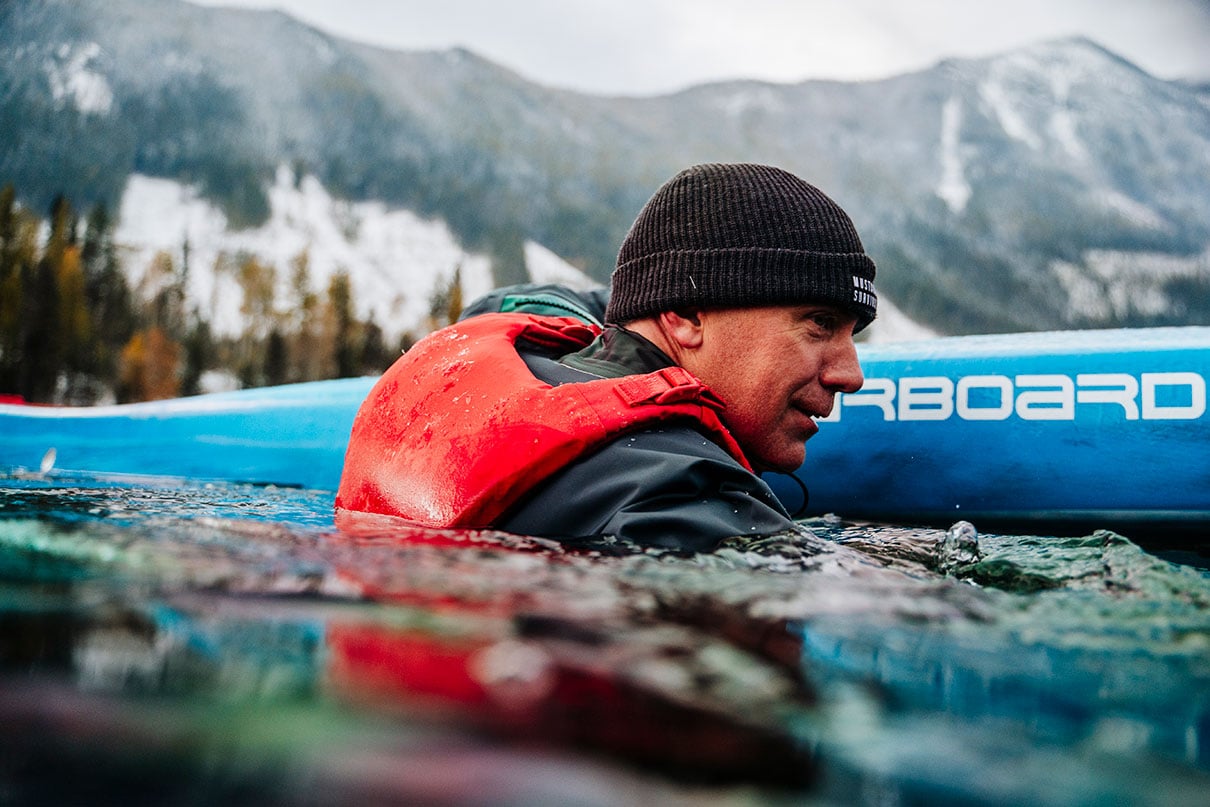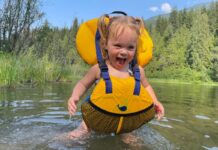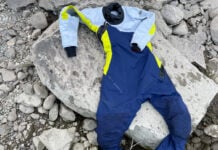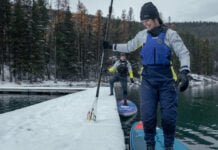Mustang Survival had no intentions of reinventing the wheel last year when it took on the challenge of updating its Hudson and Helix drysuits. The men’s- and women’s- specific models had already pioneered game-changing features when they hit the market in 2021, including the praised Closed Comfort System—a non-latex adjustable gasket. The drysuit line was also already fulfilling its number-one priority, keeping paddlers dry and warm. Yet, even with the successes of the original Hudson and Helix, another element was left to be desired.
“As industry leaders in floater jackets, we already knew a lot about keeping people safe on the water,” explains Gaby Hébert, Mustang’s product designer and manager of product development. “But we recognized that paddlers and other cold-water adventurers needed a drysuit that offered not just protection, but comfort and durability, too.”
The need for improvement was a challenge Mustang took seriously. The Helix and Hudson are drysuits for recreational paddlers following in the lineage of Mustang’s Sentinel professional rescuer series, drawing on the experience of a decades-long tenure as the preeminent brand in water safety gear for military, coast guard and search-and-rescue. With such an ardent following, Mustang acknowledged the risks of messing with a good thing when it came to doing a redesign. The main objective of Hudson and Helix 2.0 models was “elevating our existing expertise in cold-water safety,” Hébert says. “The initial designs laid a solid foundation with their overall design, but we wanted to push the envelope further with a focus on enhancing fit, durability, comfort and gender parity.”
But just how would the brand known for utilitarian applications improve upon their drysuit and accomplish these luxurious changes without sacrificing a proven drysuit worthy of its iconic seahorse logo? They needed to bring the Hudson and Helix back to the lab.

Mustang R&D at Waterlife Studio
Based just outside of Vancouver, B.C., Mustang’s Waterlife Studio has been the backdrop for the company’s recent innovations, including the dual-flotation Khimera life vest, which introduced both foam and air chambers to the inflatable PFD. Inside the corporate-looking exterior just a block from the Fraser River, the Waterlife Studio houses Mustang’s prototyping facilities, research labs to study human physiology, and real-world test pools.
In conceiving the original Hudson and Helix models, product designers spent long hours determining the right fabric options through rigorous in-water testing. Research and development focused on diverse, uncompromising users who “need something that allows them to stay warm and dry for extended periods in harsh conditions, while still offering the mobility required for their activity,” notes Hébert. “Protecting against sweat buildup, along with water intrusion, is key to preventing discomfort and helping users avoid dangerous temperature drops that can lead to hypothermia. Developing these suits meant pushing our innovation forward, staying true to our history of engineering reliable, high-performance safety gear.”
Engineers landed on three-layer, Marine-Spec BP waterproof-breathable fabric, which competes closely with Mustang’s Mil-Spec 6.5 GORE-TEX found on their professional-user gear such as the Sentinel Series Aviation Rescue Swimmer drysuit. It features Cordura reinforcements in high-wear areas, bombproof Aquaseal zippers and supreme breathability. Of course, the best fabric is nothing without quality control—a top priority in all Mustang products. “Each suit is individually tested for waterproof integrity and durability to make sure it meets the highest standards before it reaches the hands of our customers,” says Hébert.
The redesign focused on making subtle tweaks to the Hudson and Helix. These include refining the fit with a more ergonomic cut “that better contours the body, offering a more natural range of motion and reducing bulk,” explains Hébert. Original seamlines were analyzed and updated, including moving the side seams forward to eliminate rubbing while sitting in a kayak cockpit. The removable kneepads, a favorite for canoeists, are now conveniently accessible from the outside of the drysuit.

Put to the test
Mustang designers Hébert and Savannah Sami-Bacon quickly moved from the concepts drawn up in the Waterlife Studio to testing in the real world. “We had paddleboarders, kayakers, kite surfers, and sailors testing the suits, many of whom already owned the original versions,” says Sami-Bacon, a Mustang product designer. “Their excitement to contribute to the new design was infectious. Some users put over 400 wear hours on their suits in just a couple of months.”
Of course that meant a cadré of professional paddlers getting out on the water, sea kayaking and paddleboarding the Salish Sea and Howe Sound on the Pacific Ocean adjacent to Vancouver, and whitewater boating the wild rivers of British Columbia’s Coast Range. But it also included some unconventional applications. “One ambassador’s excitement was so palpable they were actually out shoveling their driveway during a heavy snowstorm in Squamish — wearing the drysuit — and showing how versatile and comfortable these suits are,” Hébert adds of handing off the redesign concept to their athletes.
The enthusiasm of the athletes provided the push the Mustang team needed to reach a finalized design, and perhaps more integral, the approach helped Hébert and Sami-Bacon avoid the risk of making the wrong changes. “Finding that perfect balance was crucial,” explains Sami-Bacon. “We didn’t want anyone to notice that we’d changed anything, but we did want to improve the overall product.”
The results of the process from the time at Waterlife Studios to time in hands were “minor refinements,” according to Sami-Bacon, that were critically analyzed in on-water testing by a focus group of professional users, with standards that match those of every paddling enthusiast. “Our target audience is pretty straightforward: cold-water paddlers who need gear that won’t let them down,” says Sami-Bacon. “The original Hudson and Helix responded to these needs by designing a suit that balances warmth, breathability, and durability. Features like adjustable seals, trimmable wrist cuffs, and the added convenience of thigh pockets all came from understanding exactly what these users needed and wanted.”

Hudson and Helix 2.0 are born
The updates that made the cut for the 2025 Hudson and Helix include more ergonomic fit, with a refined cut that contours the body and offers a more natural range of motion—in part by reducing excess bulk in key areas. Shifting the side seams forward eliminates rubbing and improves a paddler’s mobility while seated in confined places, such as the tight-fitting cockpit of a high-performance sea- or whitewater kayak. The original Hudson and Helix offered unique removable knee pads, which are perfect for whitewater canoeists and trippers. These pads are now removable from the outside, making them far easier to remove or reposition without opening the drysuit. Besides streamlining the cut, a thigh pocket was also added to the women’s specific Helix (which already features a distinct rear-entry zipper), for gender parity between the models.
Drysuits are standard issue for serious paddlers who tackle cold water—often described as the most important (and most expensive) item you’ll buy after purchasing a boat. They allow sea kayakers cross rough seas; protect standup paddleboarders from the elements in extreme environments; provide margins of safety for expedition canoeists on Arctic waters; and inspire confidence in whitewater boaters to trust their skills in first descents of wild rivers.
“Choosing a drysuit is a big decision,” says Chris Christie, a Squamish, B.C.-based photographer and Mustang ambassador who has paddleboarded amongst icebergs in the Canadian high Arctic. “This single piece of gear is a thin line of safety while operating around cold waters. I’ve used Mustang products for years and have developed trust in their designs and testing, to allow me to move efficiently over the water and give me a safety margin I can deal with.”
In improving an already superlative drysuit line, Christie says, cold-water paddlers’ “big decision” just got a whole lot easier.
Feature Photo: @nicoleleclairphotography









